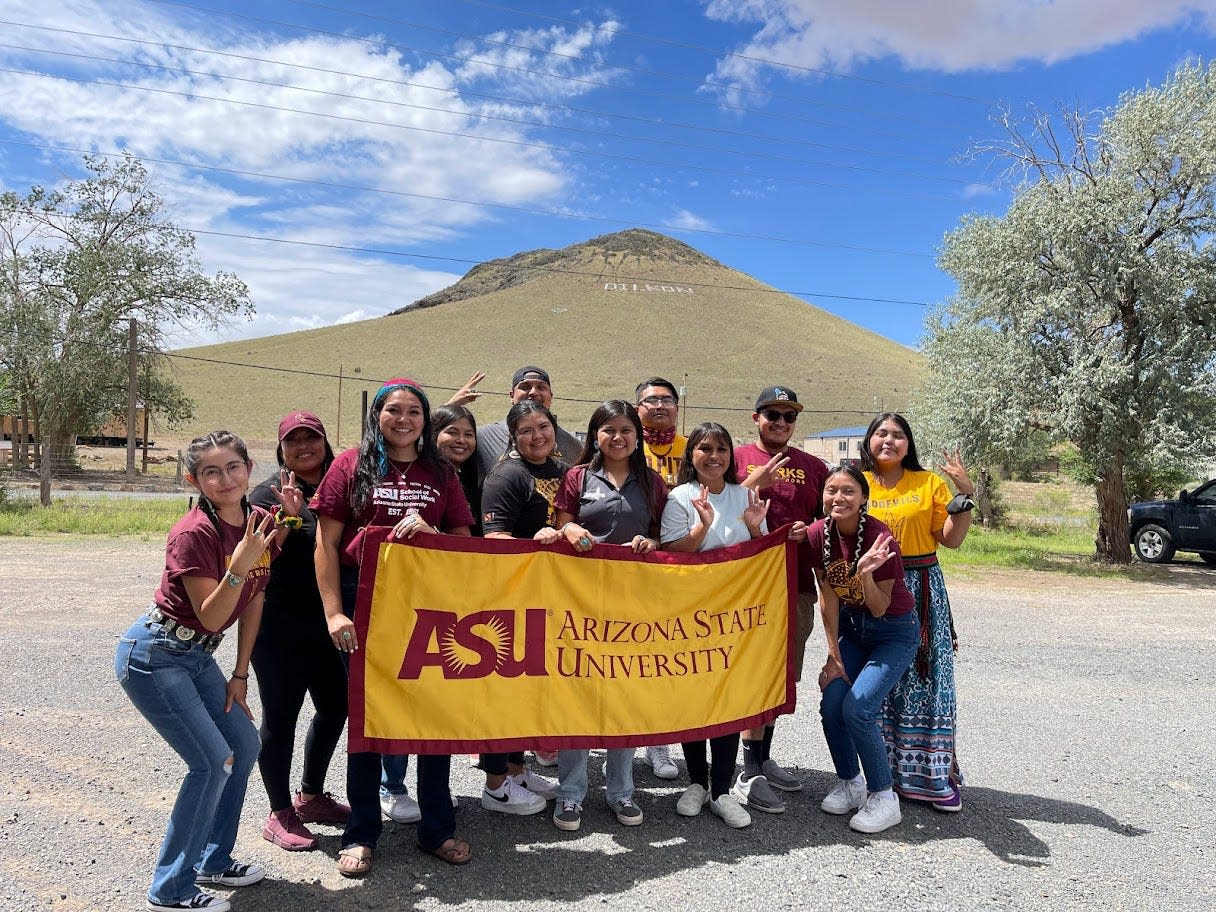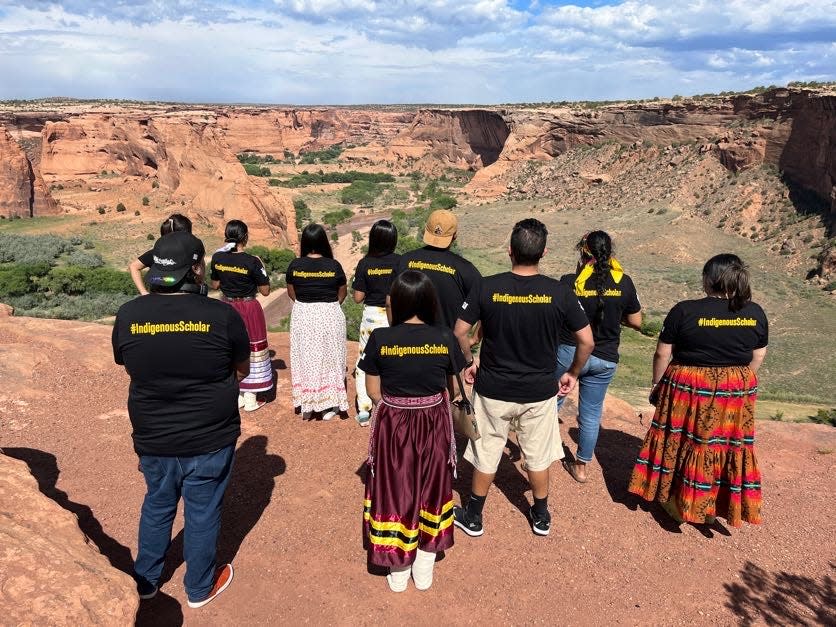ASU attracts Arizona's largest Indigenous population as Native students seek community

Lourdes Pereira started her senior year at Arizona State University last month and as she nears the end of her undergraduate career, she’s studying for her law school entrance exams, hoping to get into Sandra Day O’ Connor Law School next fall.
Pereira, who is Hia-Ced O'odham and Yoeme, doesn’t hesitate to name ASU as her choice for law school, since Sandra Day O’ Connor has the largest American Indian Policy program in the country.
She is majoring in American Indian studies, minoring in justice studies, works as an aide with the university’s Labriola lab and is a former Miss Indigenous ASU, a title she held for two years because of the pandemic.
“I picked ASU for their community,” Pereira said. “I know that ASU has the largest Indigenous community within Arizona. I know they are very active with the Indigenous students here at ASU.”
Last fall, ASU reported it had enrolled more than double the Indigenous population in undergraduate classes compared to the UA. Schools officials say it's in large part due to the community cultivated and the resources used to recruit, transition and assist students.
In Tucson, the University of Arizona began offering tuition-free courses to members of all 22 recognized Arizona tribes this fall, with a goal of boosting enrollment among Indigenous students.
But ASU’s sense of community appeals to students like Pereria.
“I’m from Tucson,” said Pereria. “I kind of already saw how University of Arizona was with their Indigenous community. I chose ASU for the engagement and community side, but I chose my majors because I would like to practice tribal law. At ASU, they have the No. 1 American Indian legal program within the nation and that’s exactly where I want to be.”
ASU connects with high school students
Annabell Bowen is Seneca and Navajo. She serves as the director for the Office of the President on American Indian Initiatives at ASU. Her focus is on recruitment and retention of Indigenous students, and coordinating and aligning academic and student services on campus. She works to implement college planning initiatives that meet the needs of K-12 schools, students and families.
She also oversees the ASU Tribal Nations Tour, which recently celebrated its 11th year.
“Its a program where we take current ASU Indigenous students who are interested, it's all volunteer, and we take them to tribal communities all over the state to primarily promote and encourage high school completion and get students to think about going on to college,” said Bowen.
Bowen said students like Pereria, who took part in the tour a couple of years ago, and ASU junior Cheneil Jones, who participated in the most recent tour, speak to young students and give them their own life stories about how they were able to transition to university life.

“They are the ones who share the message,” said Bowen. “We also highlight our resources here at Arizona State University to support our Indigenous students here. It's making ASU visible in our tribal communities and promoting tribal access.”
Understanding there are schools on tribal lands that aren’t able to hold campus tours of colleges, Bowen said the tour offers an opportunity to take ASU to the students.
Enrolling students is just one aspect, but retaining students is another and Bowen said this is where they concentrate on making known the resources available to students.
“Where we are at now there is a lot of support that has been in place speaking specifically at ASU to support our students coming in,” said Bowen. “ASU Tribal Nations Tour is just one resource that we have.”
Incoming students can find help
Another resource is the American Indian Student Support Services, which conducts a two-week transition program for incoming freshman students like Dayshon Dalgai, who just started his first year at ASU.
“My professors are really good as I start my first year,” said Dalgai, who is Navajo and graduated last spring from St. Michaels Indian School in St. Michaels. “For a different place, a different setting than on the Navajo reservation, it’s a lot different. But it's a good kind of different. It’s exciting.”
Dalgai chose to attend ASU, even though he was accepted at Northern Arizona University and the University of Southern California, because his two older siblings are ASU alumni and the tuition isn’t too expensive.
He plans to go into sports business, a major he settled on after he researched what he wanted to ultimately study. A former star basketball player in high school, he was awarded Regional Player of the Year for 1A North. He said the sports culture on the Navajo Nation was a factor into his major decision. He said he wants to get into the business of helping Indigenous athletes get exposed to “the sports world.”
“I was a student athlete at my high school,” Dalgai said. “I wasn’t really exposed to the types of big schools out there. I felt they didn’t know we were there. From experience I want to help Native American students on the reservation get really exposed, because there is some exposure here and there, but there is a lot of talent. I felt they should be more seen.”
When he took part in the two-week Spirit program, he said he was able to meet new people with the same interest in basketball and now they are looking to form a basketball team to play at the ASU Fitness Center as part of the intramural sports program.
Jones, who is Navajo and from Chinle, took part in the most recent ASU Tribal Nations Tour. The group traveled to Window Rock and spoke to schools like the Bureau of Indian Education-run Hunters Point Boarding School in Hunters Point. They also visited with students in Chinle, Sanders, Fort Defiance and Dilkon.
Jones, an elementary education major with a minor in family development, said she looks forward to one day returning home to the Navajo Nation to teach second grade. She cited two teachers from junior high and high school, along with her mom, who is a teacher, as her inspirations for going into education.
“My childhood environment inspired me to come back to make an impact somehow for the children’s mindset,” said Jones. “I want to make sure the children have a future to look forward to and I saw teaching as a way to get that for them. I also saw it as a way to open doors for opportunity and maybe change the education back home.”
But what sold her on the idea of going to ASU was the community. She gravitated toward the teaching program.
Instilling leadership in new students
Jones and Pereira both had to acclimate to online classes when the university was shut down due to COVID-19, a time Jones said her mental health suffered. Both said that point in time for them as students was difficult.
Bowen said Jones was invited to speak at a conference in Sedona on mental health. She said Jones' passion for advocacy in helping students is admirable.
“Cheneil just came into our office one day and introduced herself and basically asked how she can get involved,” said Bowen. "She said, ‘I want to participate. I want to help out and volunteer.’ Seeing that advocacy of putting herself out there, and seeing that passion in her of what she wants to do, she wants to go home and be an elementary teacher, which is needed. Just seeing her passion and enthusiasm impresses me.”
Bowen said even during the pandemic she could see how involved Pereria was with her tribe. Her leadership didn't go unnoticed: She was recently recognized as one of Native Youth Leadership Program's 25 Under 25.
“I’ve been fortunate to hold a lot of different leadership roles,” said Pereria. “In my senior year of high school I implemented a policy that allowed Native youth to wear their regalia during their graduation within Tucson Unified School District.”
For fall 2021, Arizona State University reported 1,213 American Indian or Alaska Native undergraduates, followed by Northern Arizona University, with 674 Indigenous students, and the University of Arizona with 475 undergraduate students who identified as American Indian or Alaska Native.
"I suggest Native students looks at a college that they can see themselves at and makes them happy," said Pereria. "I wouldn't have gone as far without the support and the resources that ASU, most specifically the Indigenous department here at ASU gave me.
"I always had someone to go to and talk to. So when Native students are looking for whatever school, they should do research and see if these schools fit what they want in obtaining their education."
Arlyssa Becenti covers Indigenous affairs for The Arizona Republic and azcentral. Send ideas and tips to arlyssa.becenti@arizonarepublic.com.
Support local journalism. Subscribe to azcentral.com today.
This article originally appeared on Arizona Republic: ASU's Indigenous population remains the largest in Arizona

